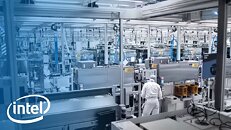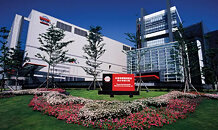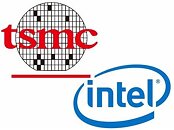Wednesday, January 13th 2021

TrendForce: TSMC to Mass-Produce Select Intel Products, CPUs Starting 2021
According to a market analysis from TrendForce, Intel's manufacturing efforts with TSMC will go way beyond a potential TSMC technology licensing for that company's manufacturing technology to be employed in Intel's own fabs. The market research firm says that Intel will instead procure wafers directly from TSMC, starting on 2H2021, in the order of 20-25% of total production for some of its non-CPU products. But the manufacturing deal is said to go beyond that, with TSMC picking up orders for Intel's Core i3 CPUs in the company's 5 nm manufacturing node - one that Intel will take years to scale down to on its own manufacturing capabilities.
According to TrendForce, that effort will scale upwards with TSMC manufacturing certain allotments of Intel's midrange and high-end CPUs using the semiconductor manufacturer's 3 nm technology in 2022. TrendForce believes that increased outsourcing of Intel's product lines will allow the company to not only continue its existence as a major IDM, but also maintain and prioritize in-house production lines for chips with high margins, while more effectively spending CAPEX on advanced R&D due to savings on fabrication technology scaling - fewer in-house chips means lower needs for investment in capacity increases, which would allow the company to sink the savings into further R&D. The move would also allow Intel to close the gap with rival AMD's manufacturing advantages in a more critical, timely manner.
Sources:
TrendForce, Via ctimes.com.tw
According to TrendForce, that effort will scale upwards with TSMC manufacturing certain allotments of Intel's midrange and high-end CPUs using the semiconductor manufacturer's 3 nm technology in 2022. TrendForce believes that increased outsourcing of Intel's product lines will allow the company to not only continue its existence as a major IDM, but also maintain and prioritize in-house production lines for chips with high margins, while more effectively spending CAPEX on advanced R&D due to savings on fabrication technology scaling - fewer in-house chips means lower needs for investment in capacity increases, which would allow the company to sink the savings into further R&D. The move would also allow Intel to close the gap with rival AMD's manufacturing advantages in a more critical, timely manner.



45 Comments on TrendForce: TSMC to Mass-Produce Select Intel Products, CPUs Starting 2021
What so Tsmc making intel chips is a step beyond Tsmc passing intel it's 7nm and beyond processes for use in its fabs ?!, Err no, while costly and embarrassing, buying chips off Tsmc will be considerably cheaper and and much smaller crazy step than Tsmc passing intel it's advantage.
I'm calling balls on it, trendforce are guessing, and getting it wrong ,Tsmc may make GPU for intel but I can't see CPU going there, unless intel go chiplet emib style on i3 and below and gave up using lower bins for them, causing Intel's wastages to increase or it can't happen.
Mostly based on wastage argument, where do they then sell their shit.
From equalocean.com/news/2020072814360
Title: Intel Might Outsource 3nm, 5nm from TSMC
Article date: July, 2020
I tried to look up what Samsung was worth a while back. It's not one company, it's a Korean conglomerate, and it's absolutely enormous. Its real name is "Samsung Group". And by enormous, I'm not talking Intel or TSMC huge, it's way bigger than that. Outside of tech that bears its name of "Samsung Electronics", Samsung is into advertising, construction, medicine and health care, shipbuilding, retail, hospitality, financial services - and the list goes on. Samsung owns amusement partks. Samsung makes apartment complexes. Samsung has built powerplants, including a nuclear power complex in the UAE.
It's so big, I was unable to determine how much it really brings in as revenue. There are 59 Samsung subsidiaries outside of Korea that are not part of the reported official revenue.
But this sure is a testament to how far Intel have fallen.
Either way, I wish AMD would have been able to capture more marketshare in mobile and enterprise before Intel started outsourcing, so that when Intel did begin outsourcing, AMD would be in a much stronger position to fight them. It's in everyone's best interests that AMD grows, and grows quickly otherwise we could be facing the same abysmal 5% performance increases year over year and innovation stagnation like we did before Zen.... And I will just give up on computers, and switch to ARM devices and consoles if Intel becomes the monoculture again. In a way, I wish Intel couldn't buy from TSMC and would be forced to lay in the bed they made for themselves... At least until AMD controlled 50% of the T.A.M. across all segments, then they could go to war, but I'm legitimately afraid of AMD being squeezed out again.
AMD's market cap is 110.38 billion this morning, meaning they are worth 110.38 billion.
AMD - Stock quote for ADVANCED MICRO DEVICES, INC. - MSN Money
Intel's market cap is 233.38 billion this morning, meaning they are worth 233.38 billion.
INTC - Stock quote for INTEL CORPORATION - MSN Money
AMD was worth the money you are talking about around 5 years ago after deciding to go fabless generating true gains with Zen1. The only company getting squeezed out currently is Intel. Apple controls the lion's share of fabs at TSMC, followed by Nvidia and AMD. Intel has needed to go semi fabless for some time now, just like AMD when they were stuck at fabs with 32nm.
TSMCs growth and fab shrinks are directly related to Apple. Apple dwarfs these other company in purchases from TSMC. Apple could purchase TSMC for their own manufacturing purchases (albeit one of the largest purchases ever made), but companies are trending away from fabbing.
Hard assets are different matter. This is the value of AMD and Intel's hard assets as of the end of 2019, in milllions :
Intel :
AMD:
www.stock-analysis-on.net/NASDAQ/Company/Advanced-Micro-Devices-Inc/Financial-Statement/Assets
www.stock-analysis-on.net/NASDAQ/Company/Intel-Corp/Financial-Statement/Assets
There is no perception. Shares x share price.
That is a correct statement as financial resources have little to do with the stock price. Intel literally has 6X the cash and cash equivalents than all of AMDs hard assets combined - meaning they can pull $36B together in a week or so.
AMD can't do that except by running the presses and making more stock, which would dilute their share price and most likely tank the stock they're selling.
So yes there *is* a difference between "funny money" aka stock valuations and cold hard assets.
Cash on hand resources, assets, and employee counts are fine when trying to say Intel is a behemoth over AMD. However from a market worth standpoint, the comparison doesn’t work.
If you want to claim to me there is volatility in Market Capitalization , fair, but the number is still the gauge of the company worth.
If Intel and AMD get into a bidding war for TSMC fab capacity, Intel will win, and it won't even break a sweat doing it. Intel has more resources, period.
The data provided during explanation was incorrect by the OP I responded to, and yourself. The market worth comment both of you provided was incorrect data.
If you want to talk about a bidding war TSMC for fab space, you don’t reference company overall worth to assess their realistic bidding power. Intel isn’t going to go all in just to win a bidding war at TSMC for fab space where they either fold or win. They will use realistic capital on hand.
You're nit-picking the meaning of the word "worth". In terms of resources, stock market valuation means nothing, and whether "worth" means actual *assets* vs *stock market valuation* is highly debatable. If you were to shut down and liquidate AMD, you'd maybe get that $6B, whereas with Intel you'd probably get that $136B. Stock values are highly subjective, actual financial resources are not.
Further, your argument is poor. Neither company is going to do the scenarios you are trying to present. Mainly you've just reframed to get a talking point about financial resources.